

Bloop 4 has a new pilot and is
flying in July 2023, in southern California. On Youtube, see:Cell Phone Bloop6-25-23 Pattern with Bloop6 11 23 Following the Bloop |
I was ...worried that the field would be busy and it would be hard to maintain ... social distancing. That ended up being no problem because there was no one
there except Bob ... whacking weeds. After opening the hangar doors and pulling the old Bloop out I ran the engine up. It started right up on the third pull. Then I warmed it up for a few minutes. I was amazed. A perfect run up with no adjustments required! Figuring now that I could trust the engine to run right, I decided to fly Bloop 2 though it was
2:30 PM and there was a strong wind with some gusting. Well, the Bloop flew well just like it always does. I did a touch and go from left hand traffic on 25
and then departed on a right hand pattern and did a full stop. Everything checked out fine... The winds made Bloop 2 climb like a Banshee over the ridges.
I was up to a thousand feet before I knew it. It turned out to be a perfect day ...
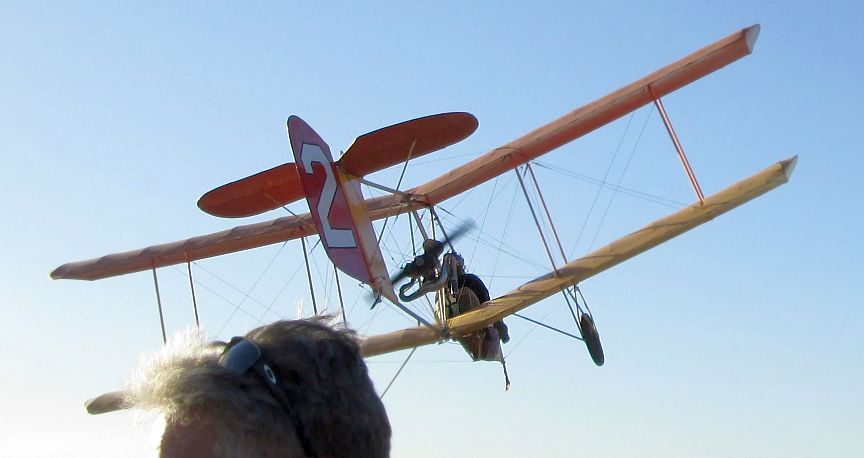
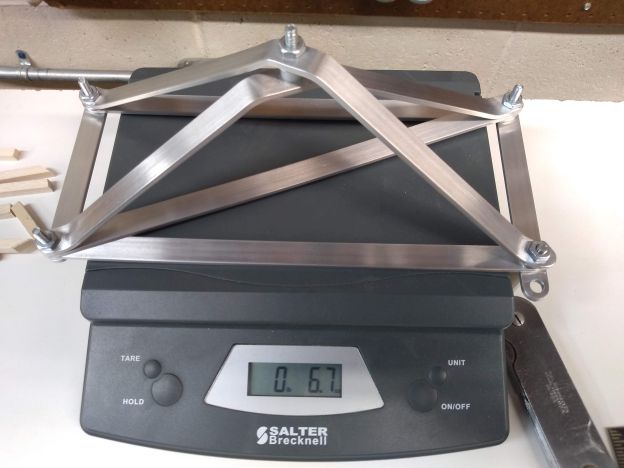
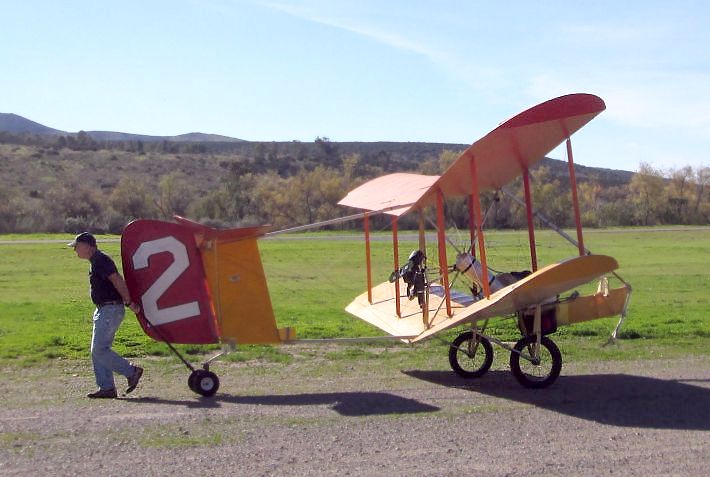
 |
November 6,
2019...Floyd's third flight of the day in Bloop 4. He is
testing his engine, it keeps faltering but he can make it
around the pattern. His fuel line components are pretty old,
they may be leaking bubbles into the fuel and probably
should be replaced.
Refurbishment
of Bloop 4 is still in progress, the trim bungee wore out
and has not been replaced yet, so Floyd has to keep back
pressure on the stick to fly at normal airspeeds.
It was fun
to watch, a good time was had by all.
|
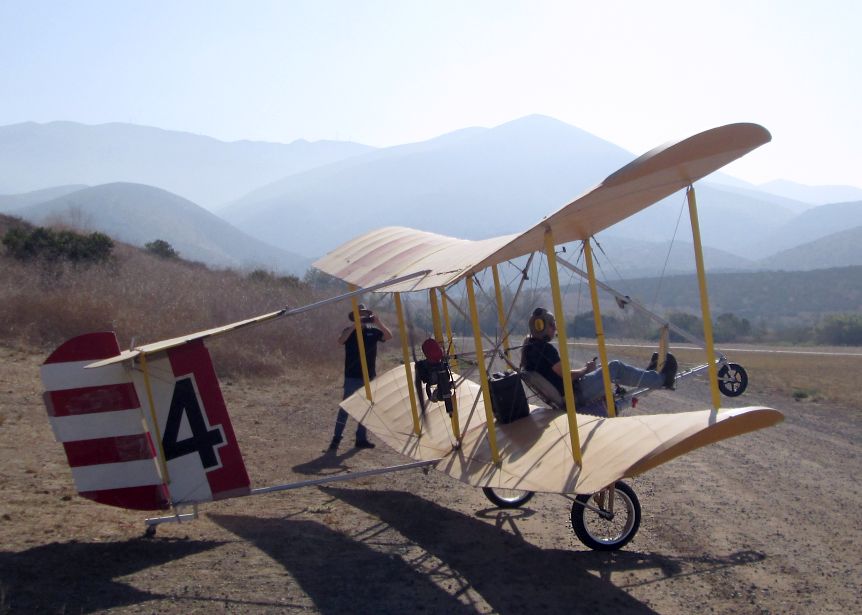 |
Bloop 4 is taxiing directly from the test anchor to the runway for the next takeoff. Both Bloops (2 & 4) have had
their small (2.5 gallon) fuel tank replaced by a 5 gallon
unit, the black box behind the pilot. The pilot can see the
fuel level in flight via a strut mounted mirror through a
translucent slot in the side of the tank.
The tail wheel castors but lacks
any elastic suspension, it needs some more ability to absorb
shock. This is another legacy item that came to Floyd with the
plane, soon to be modified
|
|
Out to the flight line for
another engine test. The engine starts well, runs fine on
the ground, but falters intermittently in the air, a hard
fault to pin down. Replacing the old fuel lines and
components won't hurt and may solve the problem.
This is the same engine I was
flying in 2011 on Bloop 1, but most of the outside parts are
not that old.
Floyd now flies with two engine
temperature instruments: CHT and EGT (cylinder
head temperature & exhaust gas temperature).
|
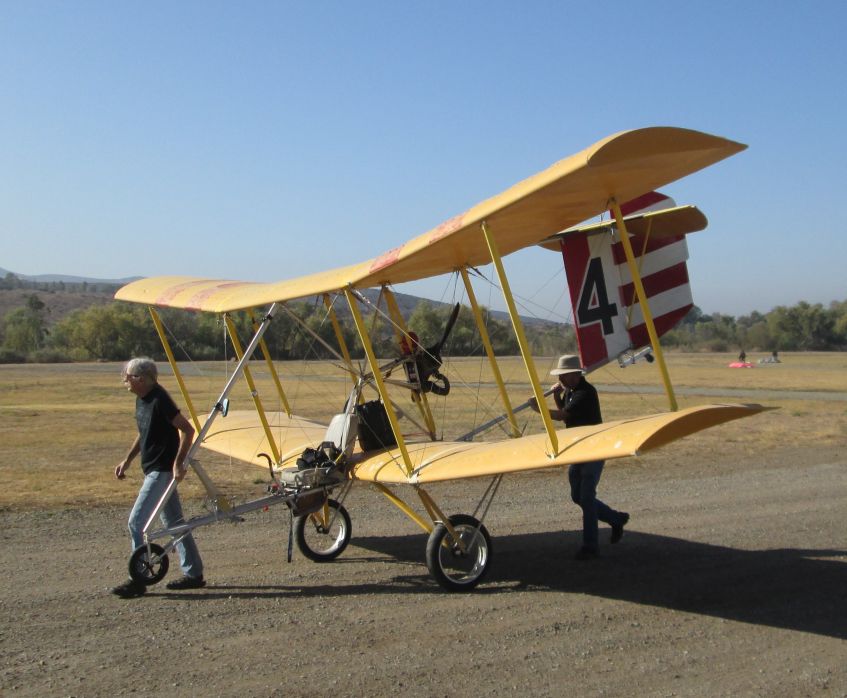 |
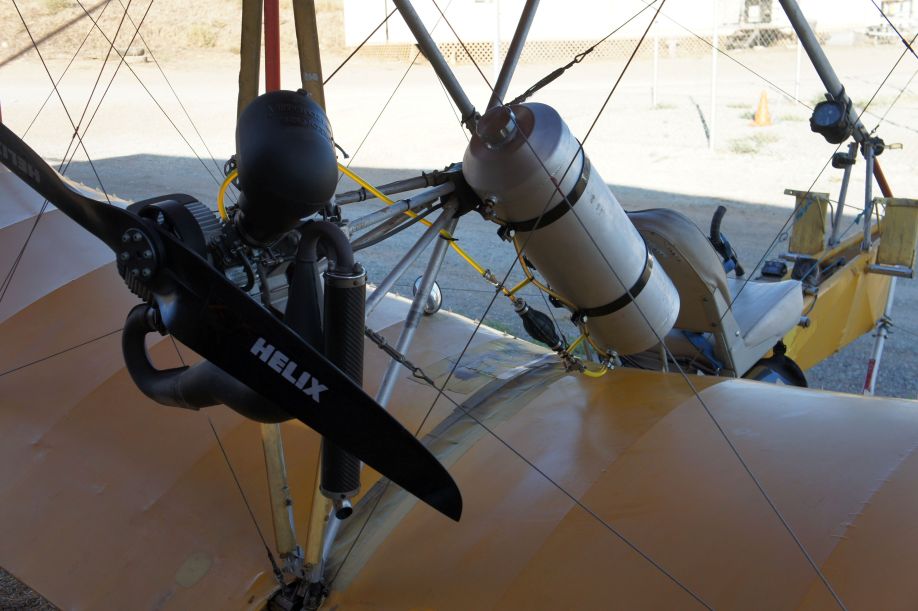
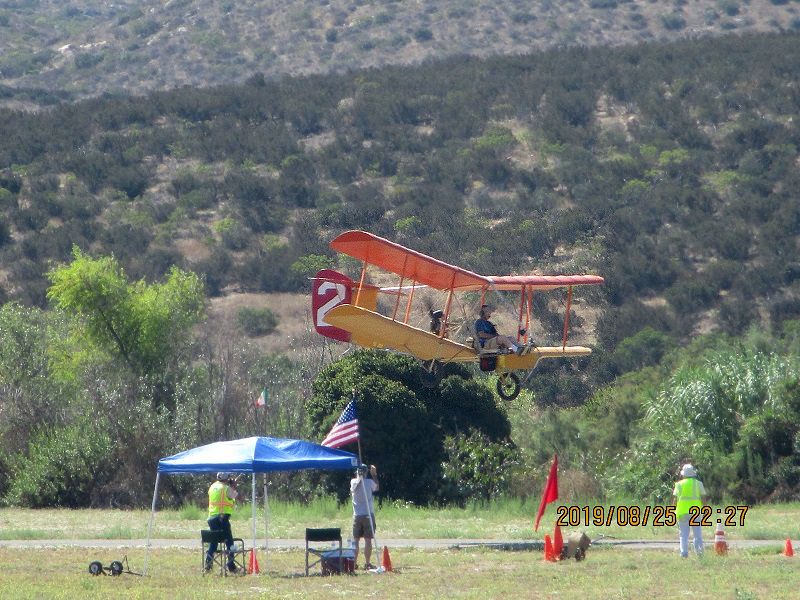

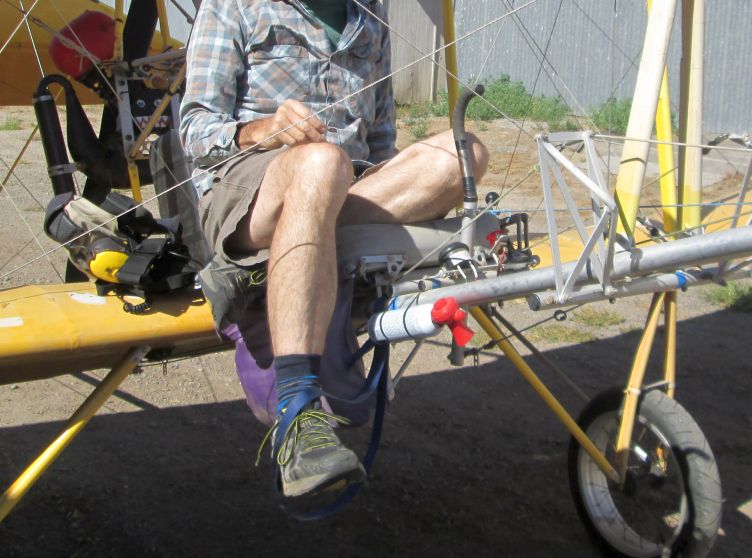
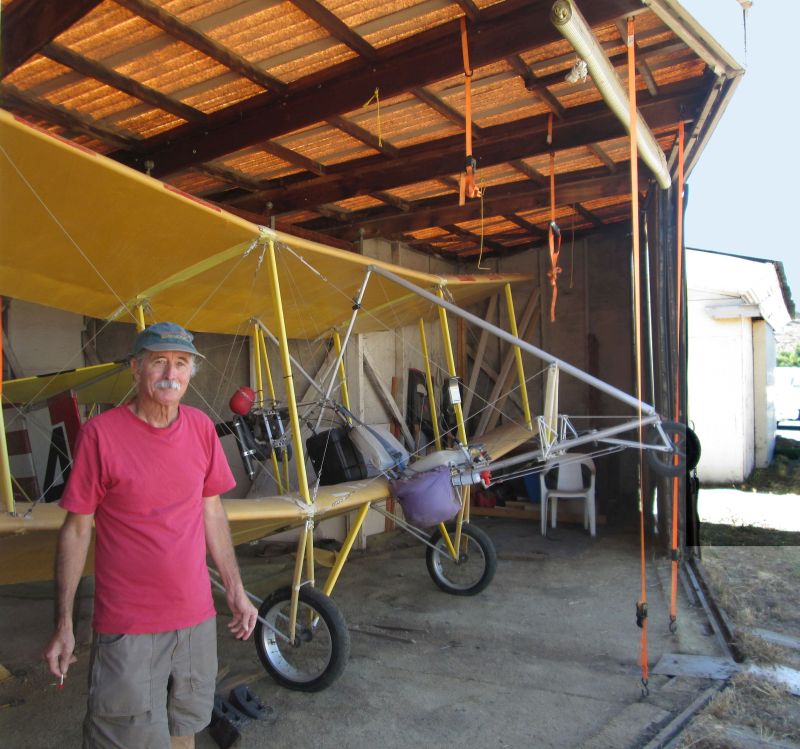
February 3,,
2019..............Glenn Frehafer has posted his own
video production of motorfloater flying.
It's mostly casual flying, just what the flying scooter is supposed to do!
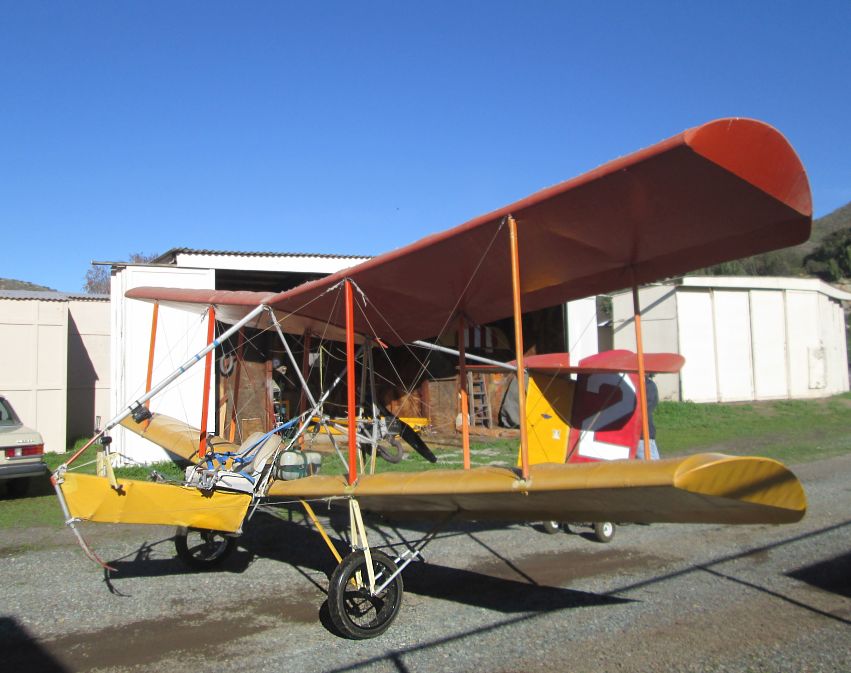 |
January 19, 2019....Nothing
special here, but the Bloops are flying.
I asked Glenn if he could get
some good video shots showing the operation of his airspeed
indicator (Hall windspeed gage), he said he would try. I
also asked him shoot a landing while steering by holding out
a a ping pong paddle (which I think would work), but he
wasn't as excited about that.
|
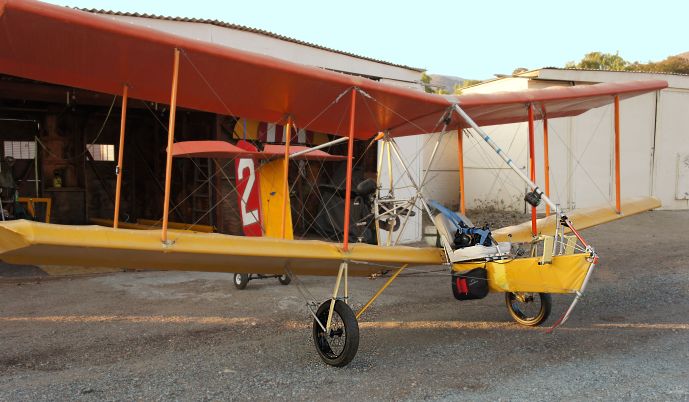 |
November 21, 2018......Now
Bloop 2 has custom fancy fat tires, just like Bloop 4 (see
opener above)! These are 20 inch diameter BMX (bicycle
motocross) tires, but the rims are 4 inches wide, to allow
lots of internal volume for shock absorption. See below for
Glenn's flight test report.
Under the tail you can see
Glenn's two wheel cart for moving the plane on the ground.
|
I
flew Bloop 2 this afternoon outfitted with a new set of fat
tires and rims! the test flight consisted of 3 touch and goes
and one full stop landing.
|
November 3, 2018...............After more than seven years of flying, this tuned exhaust pipe busted in flight. A change in sound and loss of power (rpms dropping) was noted by Matt in Bloop 4, and it progressively got worse as he flew back to the field. A new pipe is on order! Notice the aluminum bar stock bolted in place, the quick repair for an earlier breakage of the exhaust pipe mounting flange. |
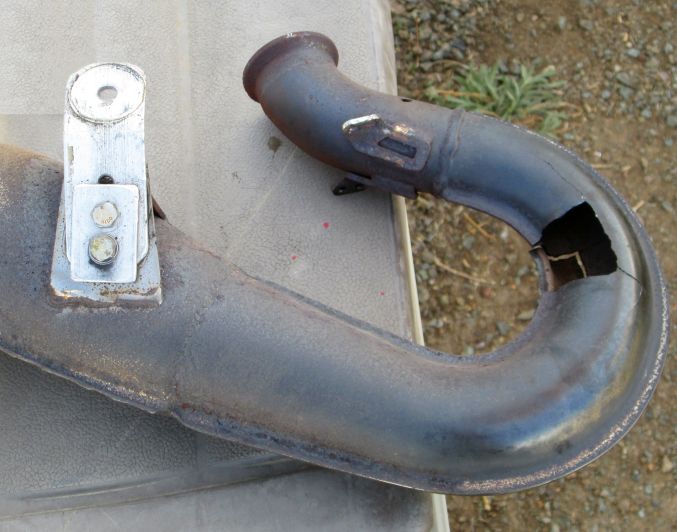 |
|
The quarter scale Bloop 4 remote
control model is shown here in my backyard workshop. This
plane has only made two flights so far, but seems to be a
success.
The idea was to make a simple RC
plane that would mimic the Bloop structure, flight
characteristics, and balance procedures. I
made it from foam board, wooden dowels, and kite string.
|
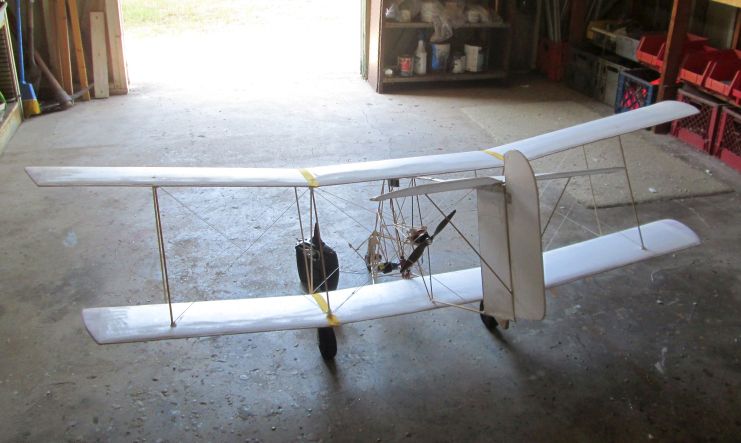 |
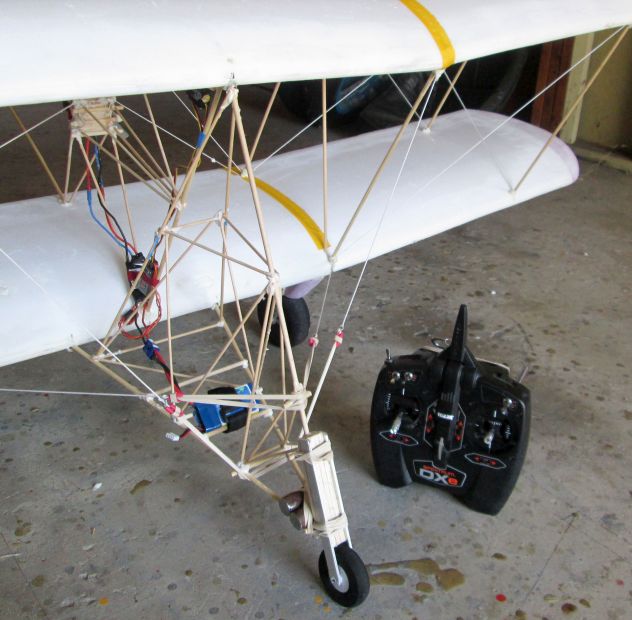 |
The Bloop QS uses an electric
motor with an 18 amp onboard controller (ordinary RC
airplane hobby equipment). I can barely fit it into my car
with the nose section removed and the control panels folded.
More flights coming soon!
|
I flew Bloop 2 this evening [Sept. 30, 2018].... Bloop 2 now has a new muffler baffle since the last one was broken inside at all of the welds and has been replaced with a new one.
I also replaced the tire that blew out in the hangar a few weeks ago [see photo below]...I am still using the skinny rims. |
|
September 2, 2018....Bloop 2
didn't get to fly today, bummer! The BMX bicycle tube and
tire blew out in the hangar. These elastic wheel parts are
too old and probably got too much sun time from when the
plane was tied down outside. The slimy mess created by the
blown out sealant adds dramatic impact to the event.
|
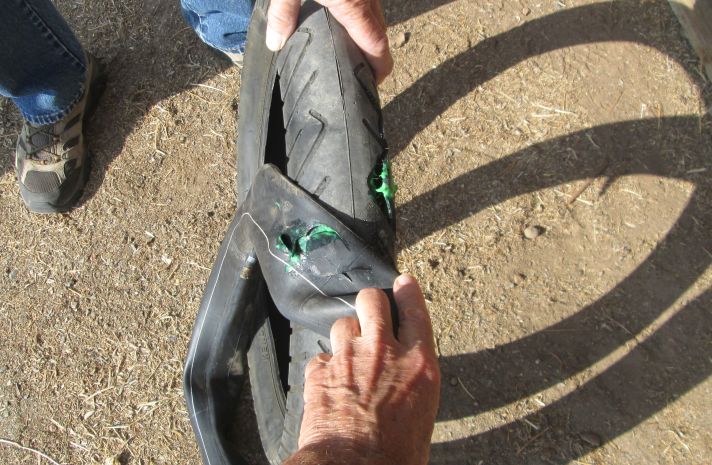 |
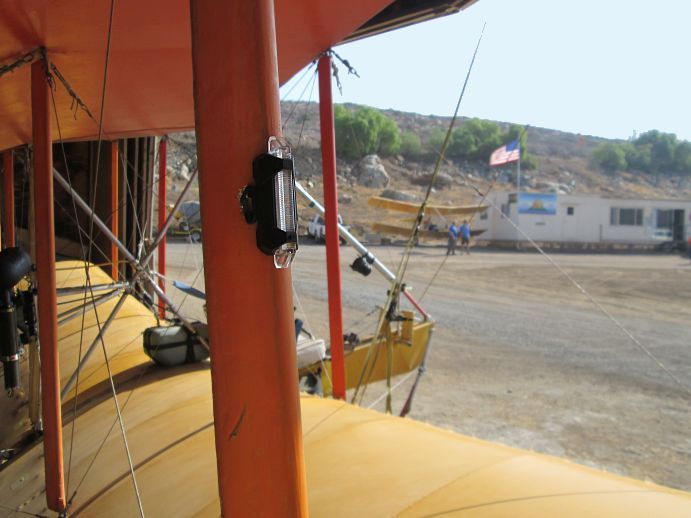 |
The disabled Bloop 2 again,
looking out from the hangar enviously at Bloop 4, which has
just been flown by a paramotor pilot. In conversation with
the new Bloop flyer I concluded that the main rules for
paramotor conversion are still valid: "keep it moving and
give it some runway".
Behold the strobe light on the
Bloop 2 strut, part of a full set of lights intended to
allow an extra half hour of operation at the end of the day.
There is also a full size aircraft altimeter mounted on the
nose strut.
A lot of Bloop flying is going
on because the weather is nice and both Moster 185 engines
seem to be operating well (unusual).
Matt has provided me with some
exciting Bloop 4 in -flight video clips! I will use them to
put together a new Youtube motorfloater action video soon,
with a link from this page. Watch for this upcoming
attraction!
|
|
August 23, 2018 ....The Bloops were flying last Sunday, here's Matt with Bloop 4 headed in from the runway. Out on the right strut I see a
Hall wind speed meter, a floating red disk in a transparent
tube, mounted for use as an airspeed indicator. This is
pretty much a standard item for open air ultralights (Bloop
2 has one also).
I did not use flight
instruments, I thought they were just a distraction, but not
everybody wants to fly like me.
At one time I claimed that a
rain gage was my only non-engine instrument, but that was
just a joke.
|
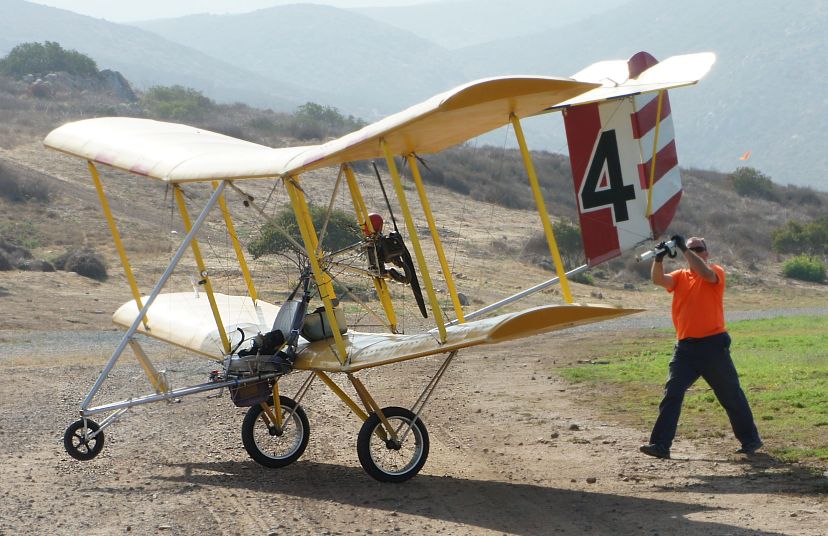 |
|
August 5, 2018 ....The Bloops are out for public display at the ultralight club summer fly-in in San Diego, California. |

|
 |
Bloops in formation have
conquered the sky! This is the high speed pass
demonstration, which looks the same as a low speed pass
demonstration.
The highest awards for short
field takeoffs and landings were swept up by the
motorfloaters. Discussion is already underway to change
the rules so other airplanes have a
chance to win.
|
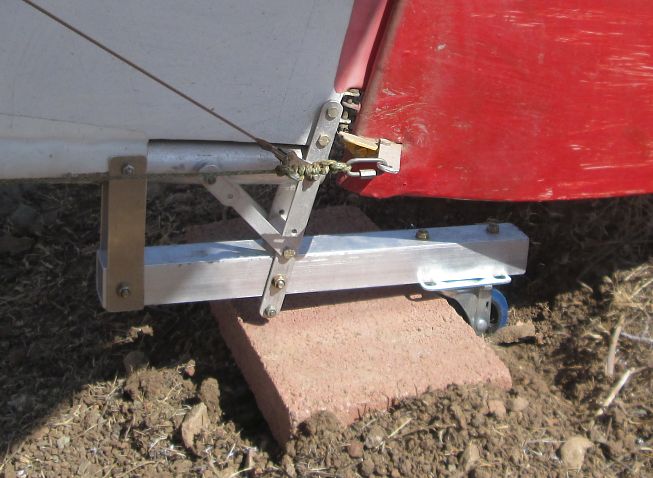 |
August 4, 2018 ....Matt
installed a taiwheel on the Bloop4, a castoring hard rubber
wheel. He says this is good for ground handling and taxiing,
but the plane no longer stays in place in idle, it wants to
move off while the pilot is trying to get in, and there is
no ground brake to stop it. I don't know how Matt will deal
with this.
|
|
July,
2018.....Matt Nokes is working on his Bloop 4 motor. I see
new elastic motor mounts and inlet boot. The vacuum line to
the carburetor is disconnected and appears to have a plug in
it, a sensible precaution for keeping crud out of the
crankcase, a level of sophistication I never reached.
The engine is now back in
operation and Bloops 2 & 4 were both flying last
weekend.
|
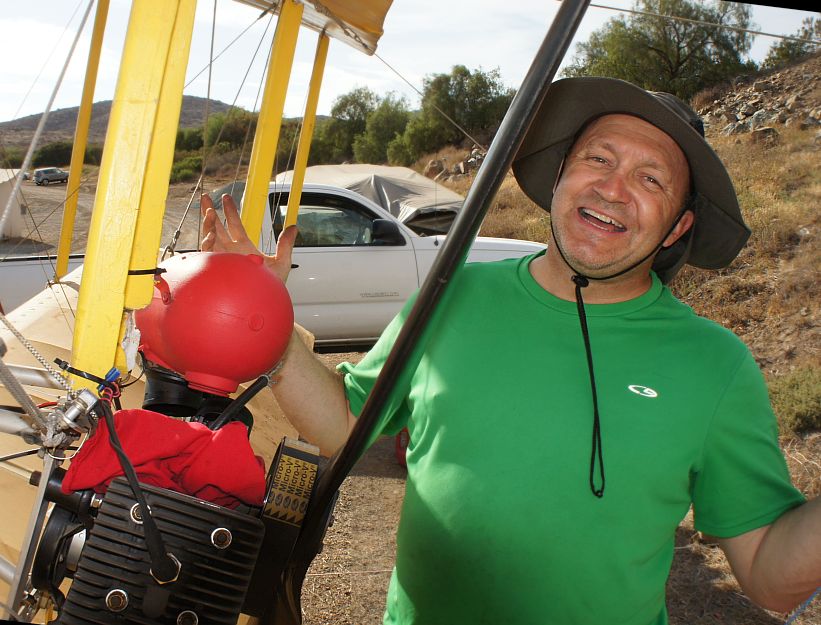 |
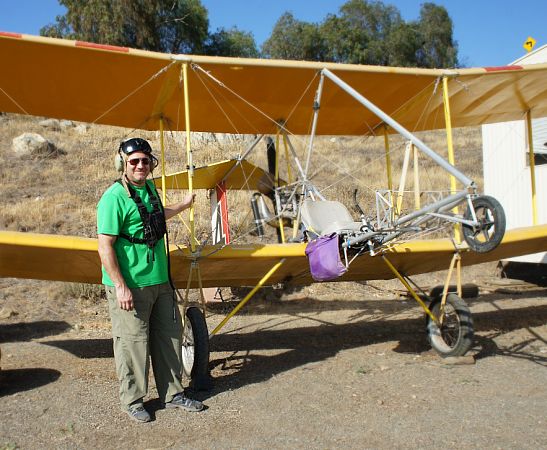
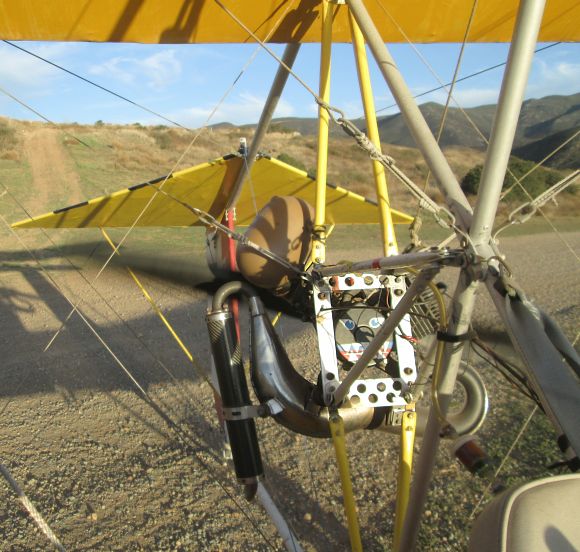 |
February 17 ,
2018.....As the motor warms up, I snap a quick
photo of the ferocious nose art on the front of
my pull starter. Someday I might re-paint the
brown air inlet bulb, maybe red with a label
"nitrous oxide boost" to see who believes it. My
paramotor system is still just a hopped up
lawnmower engine with a displacement equal to
about half a soda pop can, trading high thrust
for low reliability.
The
question was asked if I was using a lot of
turnbuckles, but I don't use them, you can see
here I am using multi-lacing for cable
tensioning.
|
|
Flying around as usual, good
vision all around and well ventilated, with my pant legs in
my socks. I don't think I would like flying in the open
behind a propeller.
I sometimes wonder if seeing
everything makes flying more intimidating, as opposed to
looking out a few windows. That would be a blow against the
easy flying experience I am trying to create.
The two white cords in the nose frame are the pitch trim bungee, going out to a pulley and back. This long trim cord is working very well and is enjoyable to fly with, a good hands off system. The small bicycle tire forward
has no inflation pressure and does not turn freely, it's
still just a skid, a low maintenance ground brake (the only
ground brake). The nose down stops seem a little awkward,
but it's good to do them about half the time to stay in
practice for when you might need a brake, or for landing in
a strong wind. Rough landings tend to become nose down
landings because the nose is already being held low during
the ground roll anyway.
I had to land into a setting
sun, poor visibility, which allowed a good approach and line
up on the field but made it hard to judge height, so my
touch down timing was off. The field was rough, so I had do
a little extra maneuvering to get good stability for takeoff
during my practice go around. I'm going back to the runway,
anyway, since open field operation seems to result with my
tires full of thorns.
|
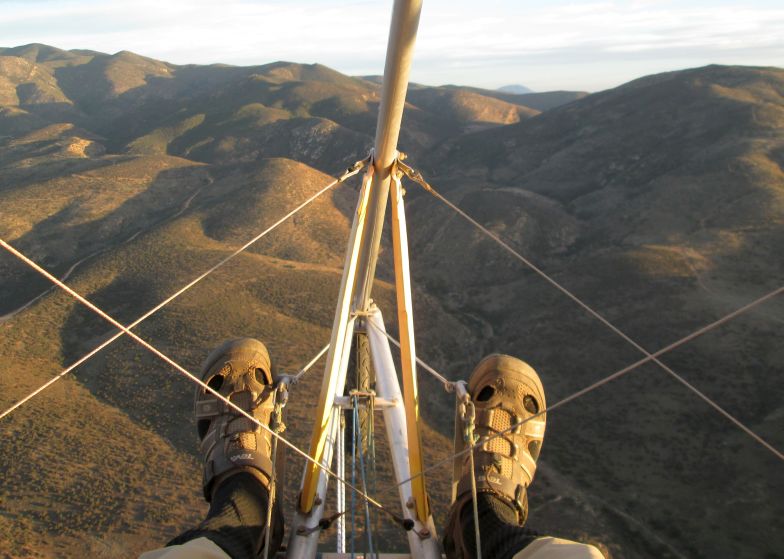 |
February 4 , 2018....I'm starting to use Draftsight 2D, free download computer assisted design software. With this I hope to eventually post the Bloop 4 drawings in an Autocad file format (dwg. format) which will be of high quality, wide useablilty, and in a file format that will be sustained, supported, and used as a native format by readily available software. To learn to use this new system is a challenge, and it has its own bugs that I must learn to work around, but I will make a sustained effort to get something done with it.
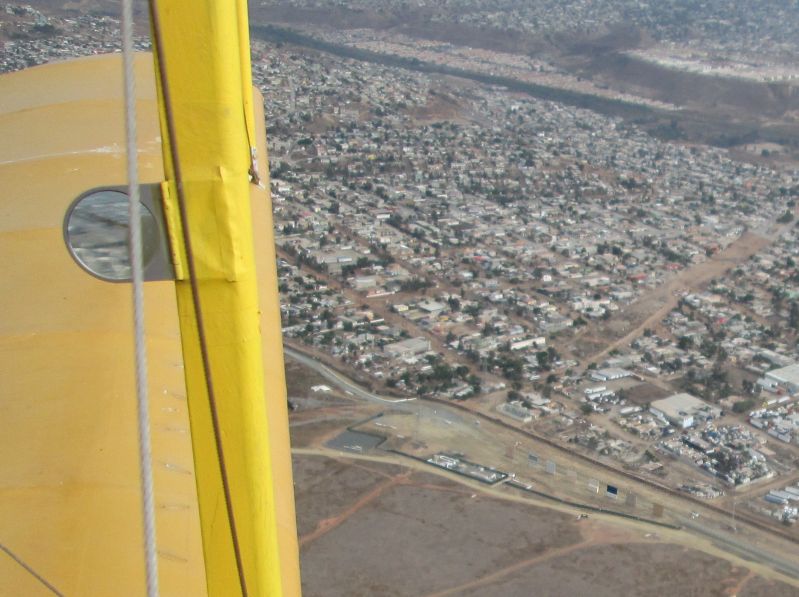 |
Today's
mission was a flight to the border to see
the prototype wall designs. Here are the
eight sections in a row, with the existing
steel wall running along the border behind
them.
In the photo you can see the
strut mounted mirror I use to determine how much gas I have
left in the translucent fuel tank behind me, although at the
angle seen by the camera in this shot the mirror is not
showing anything useful.
|
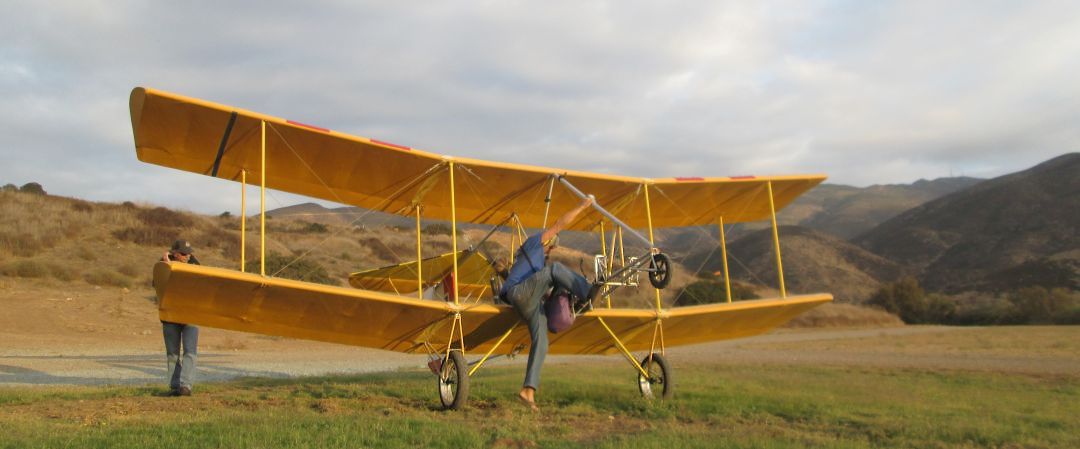
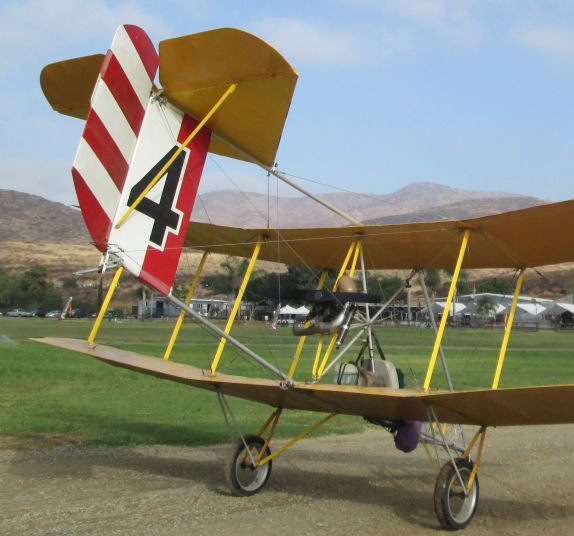 |
October 29,
2017....Test flights with the new triangular
horizontal stabilizer have shown its flight
characteristics to be spectacularly normal. The
pitch trim might be better with a little
adjustment, but this is no big event.
The
triangular stabilizer has a slightly larger area
than the former rectangular panel.
The elevator and tail struts are the same as before. |
|
The pulley block has been moved
back about six inches to keep the elevator control line well
clear of the propeller.
An added benefit is that the
pulleys are now out from under the wing and in plain sight,
where all of the control mechanisms should be for the most
effective pre-flight inspections.
|
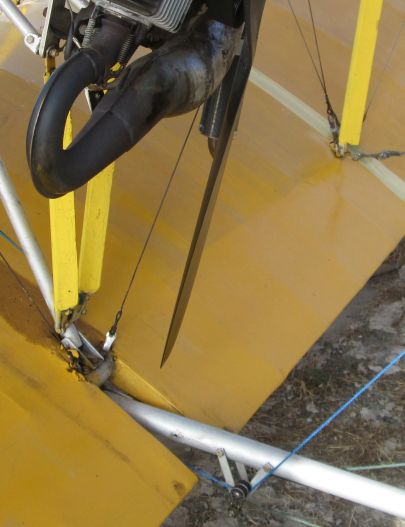 |
 |
Back at the tie down, the high
visibility color scheme is Halloween stripes. |
| October 18, 2017....I forgot the
camera yesterday, so I'll put in this recent shot of me flying
around with one spark plug and the rectangular horizontal
stabilizer, soon to be triangular if it works. I flew four touch and go landings and one full stop, all a little high but on the narrow runway (!) so I didn't pick up many thorns. At one point I did a full back snatch on the throttle, a quick move from cruise engine speed down to idle, something I seldom do since quick throttle moves may cause a marginally running engine to quit (I did this because I wanted to make a radio call without too much background noise). Usually I would push the nose down to maintain airspeed, but this time I was staying off the stick to see the plane's trim response. The response was a sedate but large change of pitch, from nose up to nose low, at the lowest of flying speeds. I just sat there and observed, wallowing at low speed until the trim caught up with the power change and stabilized the nose angle. On ordinary ultralights with bigger engines this would probably have been even more dramatic. |
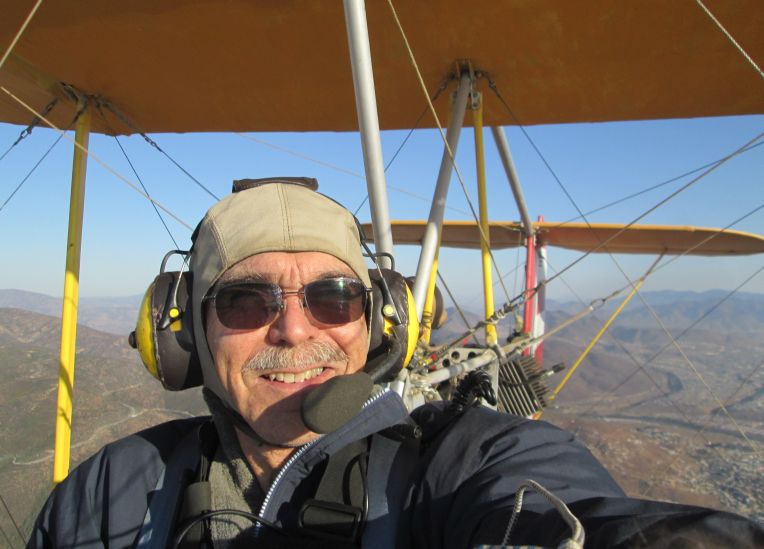 |
 |
August 24,
2017....The Bloop is under power but not moving! I
am tethered by a long line (about 60 feet) to a
ground anchor while operating the engine and flight
controls. The
forces of balance and alignment are
supplied by the propeller wake on
the tail surfaces and the tether
line pulling
on the tail. Here in the Bloop 4 I am performing a simulated ground roll and flight without actually moving. This is a training and orientation idea, so the pilot can operate all the controls and have them respond while not actually having to steer the plane. With a little ear protection an instructor could be standing right next to the pilot, providing guidance. Tethered operation is not the same as ground rolling or flight, the throttle setting has too much influence on pitch angle, but sustained operation is fairly easy and all the controls are doing what they should do. A more elaborate harness that tethers the plane at the same level as the engine might produce more realistic results. Drills on a tether might be a good starting point for a transitioning pilot who wants to know what a motorfloater feels like, although once again the ground operation is more difficult than actually flying. This method will work best for a two axis plane like this one. If there were ailerons they wouldn't be doing anything. For clarity I used some photo enhancement to make the tether line more visible. |
|
July 8 ,
2017....Some bird in distress has perched on my
cables and splattered my wing, but that's not what
this photo is really about. Rather than fly with
an altimeter, I use the local peaks as altitude
indicators in order to stay out of restricted
airspace. I am about level with the peak in the
picture, and jet liner territory doesn't start
until about a thousand feet above that, so I'm
good.
I'm about two thousand feet above my take off, at mid point in a cross country flight. I thought I was following a trio of paramotors and might catch up to them, but they went somewhere else. In a jacket and hiking shorts I was a little warm most of the time, but lower down, near the field, the air was much cooler and refreshing. |
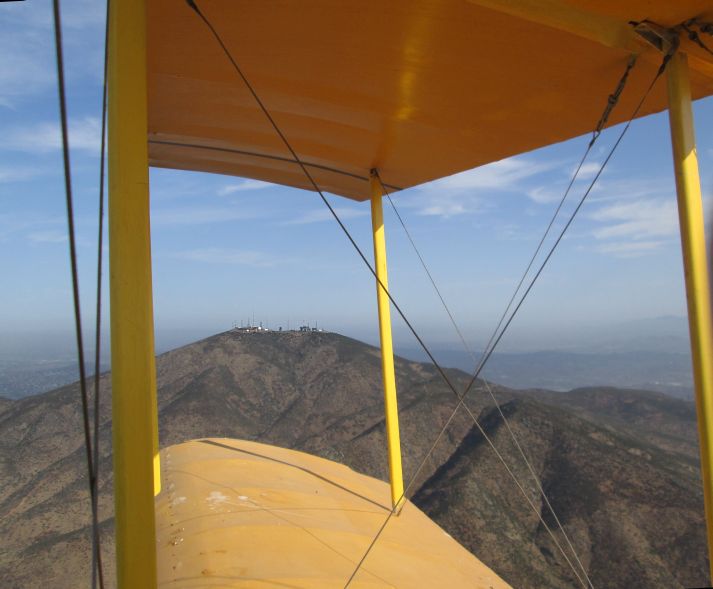 |
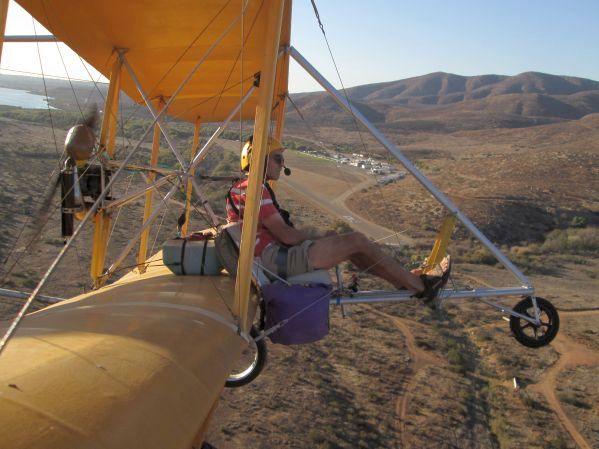 |
Here I am flying at a
more or less normal pitch attitude (close to
having the nose level), in a slight left turn.
The paved runway can be seen running visually from my knee to my chin. I usually land there in the lower right to upper left direction when I use the pavement, but normally I'm on the dirt strip, the edge between the light and dark fields leading up to my nose. I have to approach that strip over the scrubby hill to the right, which is actually pretty steep. My major goal there is to come down close to the hill and use as much of the runway as I can. Without a headwind, about a third of my runway is unusable because of the need to maintain clearance from the hillside. This is why I say if I was to add more controls, it wouldn't be ailerons, it would be airbrakes, to allow steeper approaches. This is the Bloop 4,
as you can see from the simplified nose frame,
lacking the truss work structure of earlier
designs. That original truss structure under the
pilot (not shown) was a carry over from the Goat
and Bug gliders, intended mainly for pilot
protection in a crash. For current usage I decided
that the benefits of the simplified nose frame
represented a reasonable trade off for the absence
of the under structure.
This photo was taken
before the application of the vortex generators
which are now in use on both the upper and lower
wings of Bloops 4 and 2 (see photo above).
|
|
Floyd flew out to a
local mountain top, looking south toward Mexico at
the bottom of the canyon. The outskirts of Tijuana
can be seen off to the right, this is not a clean
air day down there.
I haven't been in this area, I want some place to land when the engine quits. You could land uphill in the brush, but it would probably wipe off the landing gear. |
 |
| Floyd
prepares for data gathering as the engine warms up
(notice the spinning propeller, my paramotor power
pack does not have the increasingly popular
automatic clutch that would disconnect the prop at
low engine speeds). Not much warm up was needed, I had made an earlier flight into the back country to check out the new Indian reservation casino (no activity, parking lots are still dirt). It's wonderful to be able to take action shots with people in them instead of the usual static machinery photos I have to use for my news page. I took some takeoff shots with Floyd leaving the vicinity, walked away, turned back, and he was still there, still leaving. This is a really slow airplane! |
 |